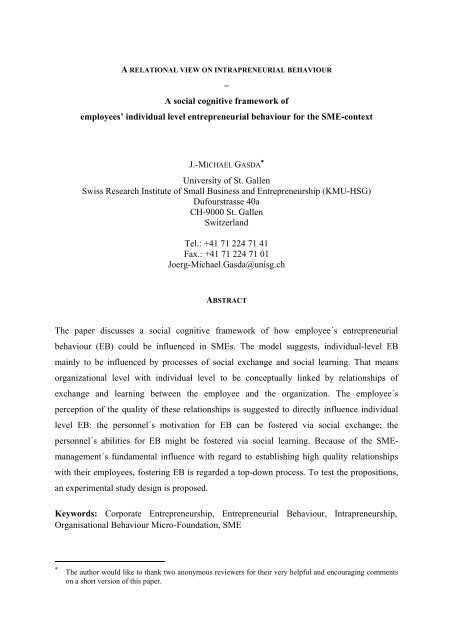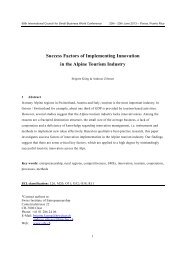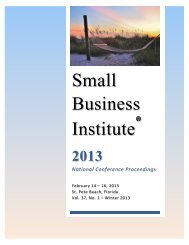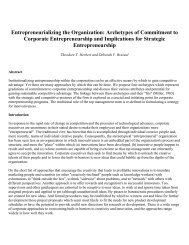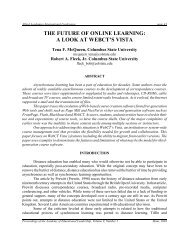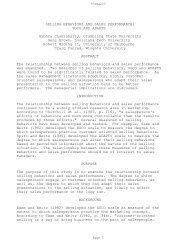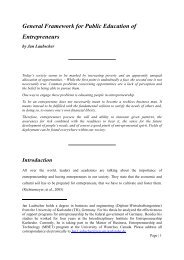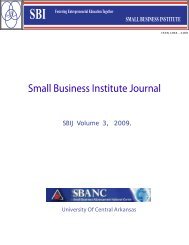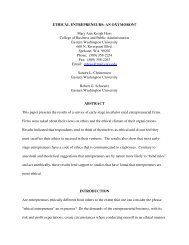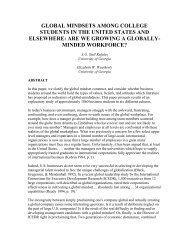individual level entrepreneurial behaviour for the SME-context
individual level entrepreneurial behaviour for the SME-context
individual level entrepreneurial behaviour for the SME-context
Create successful ePaper yourself
Turn your PDF publications into a flip-book with our unique Google optimized e-Paper software.
A RELATIONAL VIEW ON INTRAPRENEURIAL BEHAVIOUR<br />
–<br />
A social cognitive framework of<br />
employees’ <strong>individual</strong> <strong>level</strong> <strong>entrepreneurial</strong> <strong>behaviour</strong> <strong>for</strong> <strong>the</strong> <strong>SME</strong>-<strong>context</strong><br />
J.-MICHAEL GASDA <br />
University of St. Gallen<br />
Swiss Research Institute of Small Business and Entrepreneurship (KMU-HSG)<br />
Dufourstrasse 40a<br />
CH-9000 St. Gallen<br />
Switzerland<br />
Tel.: +41 71 224 71 41<br />
Fax.: +41 71 224 71 01<br />
Joerg-Michael.Gasda@unisg.ch<br />
ABSTRACT<br />
The paper discusses a social cognitive framework of how employee´s <strong>entrepreneurial</strong><br />
<strong>behaviour</strong> (EB) could be influenced in <strong>SME</strong>s. The model suggests, <strong>individual</strong>-<strong>level</strong> EB<br />
mainly to be influenced by processes of social exchange and social learning. That means<br />
organizational <strong>level</strong> with <strong>individual</strong> <strong>level</strong> to be conceptually linked by relationships of<br />
exchange and learning between <strong>the</strong> employee and <strong>the</strong> organization. The employee´s<br />
perception of <strong>the</strong> quality of <strong>the</strong>se relationships is suggested to directly influence <strong>individual</strong><br />
<strong>level</strong> EB: <strong>the</strong> personnel´s motivation <strong>for</strong> EB can be fostered via social exchange; <strong>the</strong><br />
personnel´s abilities <strong>for</strong> EB might be fostered via social learning. Because of <strong>the</strong> <strong>SME</strong>management´s<br />
fundamental influence with regard to establishing high quality relationships<br />
with <strong>the</strong>ir employees, fostering EB is regarded a top-down process. To test <strong>the</strong> propositions,<br />
an experimental study design is proposed.<br />
Keywords: Corporate Entrepreneurship, Entrepreneurial Behaviour, Intrapreneurship,<br />
Organisational Behaviour Micro-Foundation, <strong>SME</strong><br />
<br />
The author would like to thank two anonymous reviewers <strong>for</strong> <strong>the</strong>ir very helpful and encouraging comments<br />
on a short version of this paper.
GENERAL TOPIC<br />
Sustaining competitive advantages requires personnel to support <strong>the</strong> organization’s<br />
adaptiveness via <strong>entrepreneurial</strong> <strong>behaviour</strong> (EB). At <strong>the</strong> first glance, EB seems to be of<br />
relevance mainly with regard to <strong>the</strong> top-management´s <strong>behaviour</strong>, but <strong>the</strong> literature on<br />
“intrapreneurship” (e.g. Pinchot, 1985) and “corporate entrepreneurship” (e.g. Guth &<br />
Ginsberg, 1990) put emphasis on <strong>the</strong> fact that an <strong>entrepreneurial</strong> organization requires also<br />
personnel on middle- and lower hierarchies to behave <strong>entrepreneurial</strong>ly. Although <strong>the</strong><br />
concepts of intrapreneurship and corporate entrepreneurship were originally developed<br />
against <strong>the</strong> background of fostering employee´s EB in large organizations, also small- and<br />
mid-sized enterprises (<strong>SME</strong>s) might profit from <strong>the</strong>ir personnel behaving (more)<br />
<strong>entrepreneurial</strong>ly. But even though EB has been researched <strong>for</strong> quite a long time, examining<br />
<strong>the</strong> drives behind employee´s EB still deserves attention. This paper extends <strong>the</strong> microfoundation<br />
of employee´s EB in <strong>the</strong> <strong>context</strong> of <strong>SME</strong>s: I want to look at fostering (and<br />
measuring) employee’s EB by discussing a causal <strong>individual</strong> <strong>level</strong> framework of EB.<br />
THEORETICAL FOUNDATION<br />
This paper discusses a social cognitive framework <strong>for</strong> analyzing <strong>the</strong> emergence of<br />
employee´s EB within existing <strong>SME</strong>s. In comparison to large organizations, small and midsized<br />
organizations are usually characterized by in<strong>for</strong>mal institutions, flat hierarchies, and<br />
more personal relationships (e.g. Phohl, 1997). These characteristics in mind, I combine<br />
social exchange (Blau, 1994) considerations with social learning <strong>the</strong>ory (Bandura, 1989) in a<br />
social cognitive two-factor model: The <strong>individual</strong>´s EB is proposed to result from <strong>the</strong><br />
interplay of (1) personnel´s motivation and (2) abilities to act <strong>entrepreneurial</strong>ly. The social<br />
processes of exchange and learning between an employee and <strong>the</strong> organization might causally<br />
influence <strong>the</strong> <strong>individual</strong>´s EB, since <strong>the</strong>se processes influence <strong>the</strong> discovery and <strong>the</strong><br />
exploitation of <strong>entrepreneurial</strong> opportunities at <strong>the</strong> <strong>individual</strong> <strong>level</strong>. That means, <strong>the</strong><br />
conceptual linking between <strong>the</strong> organizational <strong>level</strong> <strong>behaviour</strong> with <strong>the</strong> <strong>individual</strong> <strong>level</strong><br />
<strong>behaviour</strong> is done by <strong>the</strong> relationships of social exchange and social learning.<br />
2
The proposed relational-view model allows delineating <strong>the</strong> roles of different<br />
hierarchical <strong>level</strong>s regarding <strong>the</strong>ir impact on EB: In <strong>SME</strong>s, fostering employee´s EB is a topdown<br />
process, mostly depending on <strong>the</strong> top-management´s influence on <strong>the</strong> employeeorganization<br />
relationship. This relational view might be of relevance since this view provides<br />
additionally <strong>the</strong>oretical drives of IB; usually employee’s EB is assumed to be directly driven<br />
by structural means (e.g. supportive <strong>context</strong>) or personnel´s characteristics (e.g. traits) ra<strong>the</strong>r<br />
than by relational means.<br />
RESEARCH GAPS AND CONTRIBUTION<br />
This paper´s perspective on EB is primarily an <strong>individual</strong> <strong>level</strong> one, whereas most studies of<br />
<strong>the</strong> past decades explore <strong>the</strong> phenomenon of EB at <strong>the</strong> <strong>level</strong> of organizations; regarding<br />
Corporate Entrepreneurship (CE) definitions, Sharma & Chrisman’s (1999) definition<br />
inventory only mentions two out of 26 definitions of CE to refer to <strong>the</strong> <strong>individual</strong> <strong>level</strong>. The<br />
focus on firm <strong>level</strong> contributions still dominates <strong>the</strong> current literature (e.g. Rauch et al., 2009;<br />
Lumpkin, et al., 2009; Ling et al., 2008)−although <strong>the</strong>re are calls <strong>for</strong> researching <strong>the</strong><br />
<strong>individual</strong>´s <strong>level</strong> (e.g. de Jong et al., 2011). Our framework might add to <strong>the</strong> existing<br />
literature mainly in three aspects:<br />
First, it fur<strong>the</strong>r clarifies <strong>the</strong> linkage between organizational <strong>behaviour</strong> and <strong>the</strong><br />
personnel´s <strong>entrepreneurial</strong> behavior (Kuratko et al., 2005) by applying <strong>the</strong> <strong>the</strong>ories of social<br />
exchange and social learning. Additionally, <strong>the</strong> framework assimilates aspects of social and<br />
economic exchange and contributes to <strong>the</strong> question, how and why trustful relational exchange<br />
and <strong>for</strong>mal transactional exchange substitute and complement each o<strong>the</strong>r (e.g. Klein<br />
Woolthuis, Hillebrand, & Nooteboom, 2005) and especially, why <strong>for</strong>mal transactional<br />
exchange (like e.g. pay-<strong>for</strong>-per<strong>for</strong>mance contracts) do create some instances of friction in <strong>the</strong><br />
attempt to foster IB.<br />
Second, <strong>the</strong> model proposes IB to be a higher-order construct of two factors (motivation<br />
and abilities). This conceptualization of IB allows to analyze some causal drives of IB from<br />
<strong>the</strong> employees´ point of view in <strong>the</strong> <strong>SME</strong>-<strong>context</strong> and to predict employee´s EB probability<br />
by using established scales/items living up to <strong>the</strong> <strong>SME</strong>-<strong>context</strong>. By that, <strong>the</strong> proposed model<br />
might add to Hornsby, Kuratko, & Zahra´s (2002) five-factor-CEAI-scale with regard to<br />
simplifying empirical testing.<br />
3
Third, <strong>the</strong> framework puts strong emphasize on role-model <strong>behaviour</strong> of <strong>the</strong> <strong>SME</strong>´s topmanagement<br />
with regard to influencing personnel´s motivation and abilities to act<br />
<strong>entrepreneurial</strong>ly. The interplay of different hierarchical <strong>level</strong>s regarding EB is covered by<br />
<strong>the</strong> focus of <strong>the</strong> analysis: I state <strong>the</strong> emergence of employee´s EB to be fostered by top-down<br />
processes. If <strong>the</strong> (top-) management is not considered a role model of EB and does not<br />
establish trustful exchange relations with <strong>the</strong> employees, <strong>individual</strong> <strong>level</strong> EB is not to<br />
flourish. This relational view might help to understand <strong>the</strong> influence of hierarchy-<strong>level</strong>s when<br />
analysing <strong>the</strong> impact of <strong>the</strong> environment on <strong>individual</strong> <strong>level</strong> EB (see: Hornsby et al., 2009;<br />
Kuratko et al., 2005).<br />
The text in hand is structured as follows: The first chapter discusses a two-factor model<br />
of EB and draws some propositions upon this relational-view. Afterwards, methodology to<br />
test <strong>the</strong> suggested model is presented. A conclusion with some managerial implications and a<br />
critical review is given in <strong>the</strong> last part of <strong>the</strong> paper.<br />
A SOCIAL COGNITIVE FRAMEWORK OF<br />
EMPLOYEES’ INDIVIDUAL LEVEL ENTREPRENEURIAL BEHAVIOUR<br />
FOR THE <strong>SME</strong>-CONTEXT<br />
A causal two-factor model of intrapreneurial <strong>behaviour</strong><br />
Regarding <strong>the</strong> <strong>individual</strong> <strong>level</strong>, <strong>the</strong> considerations of this paper focus on salaried employees,<br />
not being shareholders of <strong>the</strong> organisation <strong>the</strong>y work <strong>for</strong>. Referring on Pinchot´s seminal<br />
works (e.g. 1985), I regard employees´ EB as intrapreneurial <strong>behaviour</strong> (IB), which is defined<br />
as <strong>the</strong> identification and exploitation of opportunities by <strong>individual</strong> employees to benefit <strong>the</strong><br />
organization (de Jong et al., 2011). By sensing and exploiting opportunities, EB changes <strong>the</strong><br />
company’s business model or its competitive profile. EB in a broad comprehensive term is<br />
<strong>the</strong> innovative use of resources to pursue opportunities (e.g. Mair, 2005), “<strong>entrepreneurial</strong>”<br />
means identifying opportunities to create future goods or services and developing innovative<br />
approaches to exploit <strong>the</strong>se opportunities (Shane & Venkataraman, 2000; Smith & Di<br />
Gregorio, 2002) on internal or external markets by selling <strong>the</strong>m at prices greater than<br />
production costs (e.g. Schumpeter, 1934). Especially in <strong>the</strong> <strong>context</strong> of CE, sometimes <strong>the</strong><br />
associations with EB have notions of grand entrepreneurship (meaningful innovations, e.g.<br />
4
inventing a new product-line or entering a totally new business area (e.g. Mair, 2005). This<br />
paper adopts a less heroic view of EB by focussing on day-to-day entrepreneurship which<br />
means, getting usually tasks done in an <strong>entrepreneurial</strong>−that is unusual and innovative−way.<br />
From an organizational <strong>behaviour</strong> oriented point of view, this understanding of day-today<br />
EB is close to <strong>the</strong> concept of “discretionary work ef<strong>for</strong>t” (DWE), characterizing <strong>the</strong><br />
tendency of personnel to innovate and engage spontaneously beyond prescribed roles in order<br />
to promote <strong>the</strong> interests of <strong>the</strong> organisation (Katz, 1964), and by that fostering CE (e.g.<br />
Morris et al., 2007) and, in <strong>the</strong> long run, per<strong>for</strong>mance (e.g. Kanfer, 1992). In general, <strong>the</strong>re is<br />
no agreement how to link <strong>individual</strong> <strong>behaviour</strong> with corporate <strong>behaviour</strong> (e.g. Ireland et al.,<br />
2009) and this is also true <strong>for</strong> <strong>the</strong> research field of CE. There<strong>for</strong>e, <strong>the</strong> guiding research<br />
question of this paper is:<br />
Why do some employees behave <strong>entrepreneurial</strong>ly and foster CE,<br />
while o<strong>the</strong>rs in <strong>the</strong> same <strong>context</strong> (e.g. same organization) do not?<br />
Literature has tried to find answers to this question by having a look on (I) <strong>the</strong> <strong>individual</strong>´s<br />
characteristics, or (II) <strong>the</strong> organisational climate or environment, but has (III) neglected<br />
looking at relationships between employees and <strong>the</strong> organization as causal reasons <strong>for</strong> EB.<br />
Regarding <strong>the</strong> <strong>individual</strong>´s characteristics (I)−contrary to predictions−<strong>individual</strong> cognitive<br />
and emotional characteristics seem not affect EB directly (e.g. Sieger, 2011). Regarding <strong>the</strong><br />
organizational environment (II), Hornsby et al. (2002) established a measurement of an<br />
organization´s five key-factors <strong>for</strong> fostering EB (Corporate Entrepreneurship Assessment<br />
Instrument, CEAI). This model consists of <strong>the</strong> following five factors, capturing an<br />
organization’s environment <strong>for</strong> CE or–more precisely: <strong>the</strong> perception of <strong>the</strong> environment: (1)<br />
The appropriate use of rewards, (2) <strong>the</strong> support of <strong>the</strong> top management, (3) <strong>the</strong> availability of<br />
resources, (4) <strong>the</strong> organisational structure, supporting communication and learning, and (5)<br />
<strong>the</strong> organisation´s tolerance <strong>for</strong> failures and risk (“boundaries”). Now, each of <strong>the</strong>se five<br />
factors has been chosen <strong>for</strong> good reasons regarding <strong>the</strong> influence on EB (see e.g. Hornsby et<br />
al., 2002), but <strong>the</strong> causal logic behind <strong>the</strong>se factors fostering EB is very sophisticated and<br />
seems to live up more to <strong>the</strong> <strong>context</strong> of large organizations.<br />
(III) This paper wants to contribute to <strong>the</strong> research field of CE by broaching <strong>the</strong> issue of<br />
a micro foundation of employees´ EB in <strong>SME</strong>s: By adopting relationships between<br />
employees and <strong>the</strong> organization as <strong>the</strong> unit of analysis, this paper wants to discuss an<br />
additionally <strong>the</strong>oretical foundation <strong>for</strong> employees´ EB. The variance of employees´ EB within<br />
5
<strong>the</strong> same organization might be explained by <strong>the</strong> fact that <strong>individual</strong>s judge <strong>the</strong>ir relationship<br />
with <strong>the</strong>ir organization differently.<br />
Ultimately fostering EB has to distinguish from o<strong>the</strong>r topics of management (Kanter,<br />
1985) since this topic of management is concerned with future innovative <strong>behaviour</strong>. The<br />
action itself remains abstract until it is per<strong>for</strong>med one fine day (e.g. as a specific innovation of<br />
per<strong>for</strong>mance processes). In my opinion, a consequence of EB concerning abstract future<br />
<strong>behaviour</strong> is that fostering EB should focus on general factors, influencing <strong>behaviour</strong> in<br />
organisations. Such general (and to a certain degree interacting) factors are “willingness” and<br />
“ability” to behave <strong>entrepreneurial</strong>ly (e.g. Vroom, 1964; <strong>for</strong> a critical review of interaction<br />
relationship, see Terborg, 1977).<br />
By definition, <strong>entrepreneurial</strong> <strong>behaviour</strong> is self-determined acting, based on certain<br />
abilities or skills and (intrinsic) motivation (e.g. Kanfer & Ackerman, 1989). There<strong>for</strong>e I state<br />
<strong>individual</strong> <strong>level</strong> EB is causally influenced by <strong>the</strong> interplay of <strong>the</strong> factor of <strong>individual</strong>´s<br />
motivation and <strong>the</strong> factor <strong>individual</strong>´s abilities to behave <strong>entrepreneurial</strong>ly. In short, fostering<br />
personnel´s EB depends on influencing <strong>the</strong> <strong>individual</strong>’s motivation and abilities. Based on<br />
this two-factor model, I discuss a framework how abilities and willingness could be<br />
influenced.<br />
A relational view on intrapreneurial <strong>behaviour</strong><br />
The following two-factor model represents a relational point of view (see also figure 1):<br />
<strong>the</strong>ories of social exchange and social learning are applied to explain <strong>the</strong> influence on<br />
personnel´s motivation and abilities <strong>for</strong> EB: I state <strong>the</strong> <strong>entrepreneurial</strong> <strong>behaviour</strong> at <strong>the</strong><br />
organization-<strong>level</strong> to influence employees´ abilities to behave <strong>entrepreneurial</strong>ly via processes<br />
of social learning in case of employees´ motivation <strong>for</strong> EB to be given because of an<br />
established social exchange between <strong>the</strong> employee and <strong>the</strong> organization. Although<br />
willingness to behave <strong>entrepreneurial</strong>ly may be influenced by <strong>the</strong> abilities to do so (and vice<br />
versa), <strong>for</strong> analytical reasons, <strong>the</strong> aspects of motivation and abilities are dealt with<br />
independently. This approach seems to be justified since one could imagine an employee to<br />
sense opportunities but lacking <strong>the</strong> motivation to exploit <strong>the</strong>m.<br />
6
------------------------------------------------------------------------------------------------------------<br />
------------------------------------------------------------------------------------------------------------------<br />
Figure 1: Linking Organizational-<strong>level</strong> with Individual-<strong>level</strong> EB<br />
Fostering <strong>individual</strong> <strong>level</strong> motivation <strong>for</strong> intrapreneurial <strong>behaviour</strong><br />
via social exchange<br />
Regarding <strong>the</strong> <strong>individual</strong>’s motivation to act <strong>entrepreneurial</strong>, EB could be regarded as <strong>the</strong><br />
decision to co-operate in a social dilemma situation (e.g. a prisoner’s dilemma): Each<br />
employee has to decide, whe<strong>the</strong>r or not to foster CE through his or her EB (“fundamental<br />
social dilemma”, Lind, 2001). Individual <strong>level</strong> EB might profit <strong>the</strong> organization, but EB<br />
causes <strong>individual</strong> costs (direct costs, e.g. work ef<strong>for</strong>t, risk-taking, and opportunity costs, Amit,<br />
Muller, & Cockburn, 1995). From <strong>the</strong> employee´s point of view, it is rational not to per<strong>for</strong>m<br />
discretionary ef<strong>for</strong>t of EB, as long as <strong>the</strong>se costs are not compensated by rewards. That is<br />
why we have to ask what rewards could motivate cooperation. Actually this perspective is<br />
compatible with Burgleman´s view (1983), regarding motivation <strong>for</strong> autonomous, cooperative<br />
<strong>behaviour</strong> to be <strong>the</strong> basis <strong>for</strong> <strong>entrepreneurial</strong> action in organisations.<br />
In general, exchange <strong>the</strong>ory incorporates concepts seeking to explain how actors<br />
interact with one ano<strong>the</strong>r in order to exchange tangible or intangible resources. This exchange<br />
is effected in <strong>the</strong> <strong>context</strong> of an <strong>individual</strong> cost-benefit perspective and based on self-interest<br />
(Homans, 1958). 1 However, an exchange can span more than one single transaction;<br />
resources are not exchanged concurrently but in terms of reciprocity (Gouldner, 1960): One<br />
partner expects to get something back in return at some point in future―<strong>the</strong> exact <strong>level</strong> of<br />
1<br />
“Of all our many ‘approaches’ to social behavior, <strong>the</strong> one that sees it as an economy is <strong>the</strong> most neglected,<br />
and yet it is <strong>the</strong> one we use every moment of our lives―except when we write sociology” Homans, 1958, p.<br />
606.<br />
7
eciprocation as well as <strong>the</strong> time are not specified in advance (Blau, 1964). In such a case,<br />
one would regard such an exchange relationship as a social exchange.<br />
The exchange is considered “social”, because besides <strong>the</strong> exchange of economic<br />
resources, social exchange also involves socio-emotional resources (Shore et al., 2006). That<br />
means, <strong>the</strong>re is a broader range of resources to be exchanged, enabling <strong>the</strong> relationship to<br />
develop over time towards a widespread exchange. Such an in<strong>for</strong>mal exchange relationship<br />
requires more trust than a pure economic exchange, being based on <strong>the</strong> reliance of <strong>for</strong>mal<br />
institutions to en<strong>for</strong>ce <strong>the</strong> mutual pretensions presumptions associated with <strong>the</strong> exchange<br />
(Blau, 1964; Clark & Mills, 1979; Rousseau & Parks, 1993).<br />
In short, social exchanges are made in a more relational vein than a transactional vein;<br />
actors see <strong>the</strong> value of leaving some obligations broad and open ended (e.g. Tsui et al., 1997).<br />
Although interactions might be motivated by mutual expectations of <strong>behaviour</strong>al outcomes<br />
(economic-rational component of <strong>the</strong> exchange), finally <strong>the</strong> interaction is based on trust<br />
(social component of <strong>the</strong> exchange). Since in <strong>the</strong> settings of social dilemmas it would be<br />
rational <strong>for</strong> each actor not to come up with EB, I argue trust to be a pre-condition of<br />
collective rational discretionary ef<strong>for</strong>t on <strong>individual</strong> <strong>level</strong>–like personnel’s EB. I use “trust”<br />
in <strong>the</strong> terms of Mayer et al., 1995, as <strong>the</strong> acceptance of being vulnerable to <strong>the</strong> actions of<br />
o<strong>the</strong>r actors. 2<br />
Partly, I built on McAllister’s proposal (1995, 1997), distinguishing cognition-based<br />
from affect-based trust: According to my understanding, trust will be placed if an actor<br />
expects positive results from a certain interaction, and willingly bears a possible loss.<br />
Ultimately, trusting means more than just calculating an expected utility (critically:<br />
Williamson, 1993), since I assume actors not to be entirely rational but to make intentionally<br />
rational decisions: Actors are aware of <strong>the</strong>ir unawareness (“intended rationality”, Jones,<br />
1999; March & Simon, 1958). With imperfect <strong>for</strong>esight, decisions require <strong>the</strong> acceptance of<br />
uncertainty, which means that decision makers need to have a certain amount of affect-based<br />
uncertainty allowance as <strong>the</strong>y might know <strong>the</strong> amount of <strong>the</strong> potential loss, but not <strong>the</strong><br />
probability of <strong>the</strong> loss.<br />
Referring to EB as <strong>the</strong> decision to co-operate in a social dilemma, I argue <strong>the</strong> quality of<br />
exchange between an employee and <strong>the</strong> organization to be crucial <strong>for</strong> <strong>the</strong> personnel´s<br />
motivation to behave <strong>entrepreneurial</strong>ly. Thereby, we state trustful social exchange to be a<br />
2<br />
To say ‘A trusts B’ means that A expects B not to exploit an situation of vulnerability A has intently<br />
created (e.g. James, 2002). Under <strong>the</strong> condition of a social dilemma, I assume, that B has selfish interests not to<br />
react in <strong>the</strong> interest of A (‘cooperation’) but to maximise his or her own interest which by definition are not <strong>the</strong><br />
interests of B.<br />
8
pre-condition of <strong>individual</strong>-<strong>level</strong> EB and not a moderator, mediator (e.g. Robinson &<br />
Morrison, 1995) or an outcome of EB. 3<br />
Proposition 1a: The more <strong>the</strong> exchange relation between an employee and <strong>the</strong><br />
organisation can be considered as a social exchange, <strong>the</strong> higher is <strong>the</strong> employee´s<br />
EB.<br />
In case of fostering <strong>the</strong> employee´s EB via economic exchange (e.g. by pay-<strong>for</strong>per<strong>for</strong>mance),<br />
I assume <strong>the</strong> motivation <strong>for</strong> <strong>individual</strong>-<strong>level</strong> EB to be reduced (crowding-outeffect):<br />
From a contractual point of view, transactional exchanges like pay-<strong>for</strong>-per<strong>for</strong>mance<br />
provide incentives <strong>for</strong> re-negotiating compensation ex post and by that cause shirking (see<br />
e.g. Hart & Moore, 2006). From a risk-aversion point of view, a pay-<strong>for</strong>-per<strong>for</strong>mance relation<br />
could limit <strong>the</strong> employee´s motivation <strong>for</strong> EB when <strong>the</strong> per<strong>for</strong>mance-pay does not adequately<br />
compensate <strong>the</strong> employee <strong>for</strong> bearing risk from <strong>the</strong> angle of <strong>the</strong> employee (Manso, 2011). In<br />
case of risk-averse employees but risk-neutral organizations, fostering EB by <strong>for</strong>mal<br />
transactional exchange incentive schemes cannot be done efficiently. That is why I state<br />
in<strong>for</strong>mal relational social exchange to be more efficient when it comes to foster employees´<br />
motivation <strong>for</strong> EB.<br />
Proposition 1b: The more <strong>the</strong> exchange relation between an employee and <strong>the</strong><br />
organisation can be considered as an economic exchange, <strong>the</strong> lower is <strong>the</strong><br />
employee´s EB.<br />
Now, in <strong>SME</strong>s <strong>the</strong> quality of relational exchange is mainly influenced by <strong>the</strong> topmanagement<br />
directly, because of low <strong>level</strong>s of bureaucratic means to influence relationship<br />
quality (e.g. corporate governance structures) and high <strong>level</strong>s of in<strong>for</strong>mal personal<br />
interaction. There<strong>for</strong>e, I state relationship quality to be influenced mainly via a top-down<br />
process: The management has to initiate trustful social exchange between employees and<br />
3<br />
This understanding is compatible with that of Organ (1988), who seems to be one of <strong>the</strong> first authors to<br />
document citizenship <strong>behaviour</strong> based upon a social exchange interpretation. However and in particular <strong>the</strong><br />
research dealing with organizational citizenship <strong>behaviour</strong> (OCB) has been conducted largely without a<br />
<strong>the</strong>oretical framework (e.g. Konovsky & Pugh, 1994).<br />
9
organization (<strong>the</strong> last represented by <strong>the</strong> top-management) (e.g. Konovsky & Pugh, 1994;<br />
Dirks & Ferrin, 2002).<br />
Fostering <strong>individual</strong> <strong>level</strong> abilities <strong>for</strong> intrapreneurial <strong>behaviour</strong><br />
via social learning<br />
The processes of social exchange can generate personnel´s motivation <strong>for</strong> EB by providing an<br />
incentive <strong>for</strong> EB since in case of social exchange, employees believe <strong>individual</strong>-<strong>level</strong> EB to<br />
pay-off <strong>for</strong> <strong>the</strong>m in <strong>the</strong> long run. Besides this motivation, EB requires to recognize<br />
opportunities <strong>for</strong> behaving <strong>entrepreneurial</strong>ly.<br />
The processes of how and why opportunities are made or discovered are still unclear.<br />
One dominate view is, opportunity recognition to be a cognitive process (Baron, 2006) and<br />
pattern recognition to be a key component of opportunity recognition (Baron & Ensley,<br />
2006). Kurt Levin and colleagues (1939) were <strong>the</strong> first authors describing “<strong>the</strong> situation” in<br />
an organization to be a main driver of personnel´s <strong>behaviour</strong> (Ross & Nisbett, 1991, quoted<br />
in: Bowen & Ostroff, 2004). The “situation” within an organization does not influence<br />
personnel´s <strong>behaviour</strong> per se, but <strong>the</strong> fact that a certain situation is perceived against <strong>the</strong><br />
background of cognitive schemes or maps influences <strong>behaviour</strong> (Drazin et al., 1999, social<br />
cognition, Bandura, 1991). Perceiving a situation allows <strong>the</strong> observer to learn. According to<br />
Albert Bandura´s social learning <strong>the</strong>ory (e.g. Bandura, 1976, 1979), learning does not require<br />
making an experience on one´s own, since learning can also result from observing o<strong>the</strong>r<br />
people`s <strong>behaviour</strong> in certain situations.<br />
In psychological terms, a situation would be considered “strong”, when it (1) causes<br />
similar expectations about appropriate response patterns by different observers, (2) provides<br />
an incentive <strong>for</strong> per<strong>for</strong>ming well, and (3) instils <strong>the</strong> required skills <strong>for</strong> handling <strong>the</strong> situation<br />
(Mischel, 1973). With regard to social learning, strong situations mean, that <strong>the</strong> more an<br />
organisation sends signals about EB being important and a strategic goal of <strong>the</strong> organization,<br />
that <strong>individual</strong>-<strong>level</strong> EB is expected and to be rewarded, <strong>the</strong> more likely employees are to<br />
recognize opportunities <strong>for</strong> behaving <strong>entrepreneurial</strong>ly. Such signals can be sent by many<br />
kinds of HRM practices, like a) selection of personnel, b) training, c) given appraisal, and d)<br />
rewards, or e) <strong>the</strong> job design itself. Regarding <strong>SME</strong>s, <strong>for</strong>mal HRM practices are less likely to<br />
10
e found and <strong>the</strong>re<strong>for</strong>e in<strong>for</strong>mal practices are more likely to influence <strong>the</strong> perception of<br />
situations as strong.<br />
Especially <strong>the</strong> role model <strong>behaviour</strong> provided by <strong>the</strong> supervisors or <strong>the</strong> topmanagement<br />
has a lot of influence on <strong>the</strong> perception of a situation: Role model <strong>behaviour</strong> can<br />
create strong situations (Bowen & Ostroff, 2004), when <strong>the</strong> <strong>behaviour</strong> is (I) distinctive, (II)<br />
consistent, and (III) consensus. The management´s <strong>behaviour</strong> can be distinctive, when<br />
supervisors act visibly (e.g. by occasionally fulfilling operative tasks), when <strong>the</strong>y are<br />
legitimated by status and have high credibility, when <strong>the</strong>y provide reasons <strong>for</strong> <strong>the</strong>ir<br />
<strong>behaviour</strong>, and when <strong>the</strong>ir <strong>behaviour</strong> is of relevance <strong>for</strong> <strong>the</strong> <strong>entrepreneurial</strong> strategy of <strong>the</strong>ir<br />
organisation. Besides <strong>the</strong>se aspects of distinction, in order to create strong situations, <strong>the</strong><br />
management’s <strong>behaviour</strong> has to be consistent over time and has to be per<strong>for</strong>med in consensus<br />
with <strong>the</strong> organization’s members.<br />
Especially in <strong>SME</strong>s, <strong>the</strong> management is able to create strong situations: Because of flat<br />
hierarchies, <strong>the</strong> management´s <strong>behaviour</strong> is more likely to be observed by <strong>the</strong> employees; in<br />
many <strong>SME</strong>s, <strong>the</strong> top management even is in charge of certain operative tasks (e.g. product<br />
development, or customer care). Additionally, low <strong>level</strong>s of bureaucracy allow <strong>the</strong> topmanagement’s<br />
<strong>behaviour</strong> to have an immediate impact and a high legitimacy–especial in <strong>the</strong><br />
case of owner-management. Taken toge<strong>the</strong>r, in comparison to lager bureaucratic<br />
organizations, <strong>the</strong> <strong>SME</strong>-manager can create a strong organizational climate more easily. A<br />
strong organizational climate describes a high extent to which employees interpret a situation<br />
similarly (Schneider et al., 2002).<br />
With regard to social learning, a strong climate of EB might be helpful when it comes to<br />
foster employees´ EB. I consider <strong>the</strong> <strong>entrepreneurial</strong> orientation (EO) of an organization <strong>the</strong><br />
employees perceive as a proxy <strong>for</strong> a strong organizational climate of EB. When employees<br />
can judge <strong>the</strong> degree of <strong>the</strong> organization’s EO and when <strong>the</strong> degree of EO is considered to be<br />
high, one can assume that such a strong situation will influence employee’s abilities <strong>for</strong> EB<br />
by processes of social learning. In contrast to o<strong>the</strong>r ways of learning (e.g. learning from<br />
feedback), resource allocation <strong>the</strong>ory (Kanfer & Ackerman, 1989) might propose, that social<br />
learning does not to lead to overwhelming in<strong>for</strong>mation (e.g. Lam et al., 2011), since<br />
in<strong>for</strong>mation via role models is not actively given to employees, but passively absorbed. By<br />
that, role-model learning is less likely to direct cognitive resources away from <strong>the</strong> personnel´s<br />
tasks. There<strong>for</strong>e I state:<br />
11
Proposition 2: The more an employee considers an organisation’s orientation as<br />
<strong>entrepreneurial</strong>, <strong>the</strong> higher is <strong>the</strong> employee´s EB.<br />
Drivers of EB in organisations:<br />
Social-cognitive model <strong>for</strong> <strong>the</strong> <strong>SME</strong>-<strong>context</strong><br />
To summarize <strong>the</strong> argumentation given so fare: I proposed a framework model discussing<br />
relationships in organizations to influence EB, taking into account <strong>the</strong> main characteristics of<br />
<strong>SME</strong>s: flat hierarchies, in<strong>for</strong>mal structures/institutions, and more directly personal<br />
interactions. The proposed model (see also figure 2) can be considered a social cognitive one:<br />
(I) Motivation to behave <strong>entrepreneurial</strong>ly is supposed to be influenced by <strong>the</strong> processes of<br />
social exchange; (II) abilities to recognize and exploit opportunities a might be influenced by<br />
processes of social learning. All toge<strong>the</strong>r, <strong>the</strong> emergence of EB is driven by <strong>the</strong> interaction of<br />
social processes as well as cognitive ones.<br />
---------------------------------------------------------------------------------------------------------------<br />
---------------------------------------------------------------------------------------------------------------<br />
Figure 2: Two-factor Model of Employee´s EB<br />
Thereby, <strong>the</strong> proposed causal model of EB is based on <strong>the</strong> following simplification: The<br />
emergence of EB is more likely to be directly influenced by social cognitive processes within<br />
<strong>the</strong> organization (that means: social exchange and social learning between an employee and<br />
12
<strong>the</strong> organization) than by personnel´s characteristics (e.g. <strong>individual</strong> <strong>entrepreneurial</strong><br />
orientation). From an organizational-economics point of view, I argue <strong>individual</strong> <strong>behaviour</strong> to<br />
be more influenced by <strong>individual</strong> perception of <strong>the</strong> employee-organization relationships than<br />
by <strong>individual</strong> characteristics. There<strong>for</strong>e:<br />
Proposition 3a: Within <strong>the</strong> same organizational settings of high social<br />
learning potential (represented by a high EO on organizational <strong>level</strong>),<br />
personnel with an <strong>individual</strong>ly supposed higher <strong>entrepreneurial</strong> orientation<br />
(e.g. <strong>for</strong>mer self-employed, freelance staff, or employees with an<br />
<strong>entrepreneurial</strong> family background) do not show a higher <strong>individual</strong> EB<strong>level</strong><br />
in comparison with <strong>the</strong> o<strong>the</strong>r personnel.<br />
Of course, <strong>the</strong> argumentation given above neglects <strong>the</strong> perception of relationships to be<br />
probably influenced by <strong>individual</strong> characteristics. In order to get some more insights on this<br />
aspect, I would like to test:<br />
Proposition 3b: Within <strong>the</strong> same organizational settings of low social<br />
learning potential (represented by a low EO on organizational <strong>level</strong>),<br />
personnel with an <strong>individual</strong>ly supposed higher <strong>entrepreneurial</strong> orientation<br />
(e.g. <strong>for</strong>mer self-employed, freelance staff, or employees with an<br />
<strong>entrepreneurial</strong> family background) do not show a higher <strong>individual</strong> EB<strong>level</strong><br />
in comparison with <strong>the</strong> o<strong>the</strong>r personnel.<br />
SUGGESTED METHODS<br />
The data-collection has not been finished yet. That means <strong>the</strong> paper to remain on a conceptual<br />
<strong>level</strong> right now. I intend to test <strong>the</strong> propositions mentioned above via structural equation<br />
modelling and linear hierarchical regressions and hope to present first findings during <strong>the</strong><br />
paper presentation at <strong>the</strong> ICSB 2012.<br />
Although EB is a popular topic in current research, no agreement is to be found<br />
regarding <strong>the</strong> measurement of EB. Even though Pearce and colleagues (1997) suggested a<br />
useful measurement-scale <strong>for</strong> EB, this measurement has not been broadly adopted in<br />
literature. That is why in this paper, <strong>the</strong> conceptualization of EB is directed towards<br />
13
intrapreneurial <strong>behaviour</strong>, which is regarded to be a higher order construct of innovativeness,<br />
proactiveness and risk taking. I measure EB directly via <strong>the</strong> proband´s task per<strong>for</strong>mance<br />
(profit-rate) during <strong>the</strong> experimental study. Since social learning, social exchange and<br />
entrepreneurship require a process-view (e.g. Shane et al., 2003), experimental studies are<br />
preferred to static observations or surveys.<br />
To collect data, I use an experimental study. Based on a computer-simulation, probands<br />
are given a task to behave <strong>entrepreneurial</strong>ly: Each proband has to run a virtual coffee shop <strong>for</strong><br />
20 periods. After every period, <strong>the</strong> proband gets feedback on <strong>the</strong> shop´s per<strong>for</strong>mance (total<br />
profit per period) and ano<strong>the</strong>r one-dimensional in<strong>for</strong>mation to adjust parameters (regarding<br />
e.g. product, place, promotion, or price) in order to generate a higher profit during <strong>the</strong> next<br />
period. Probands are selected to different settings at <strong>the</strong> beginning of <strong>the</strong> experiment. The<br />
experimental design will differ with regard to social learning and social exchange: One part<br />
of <strong>the</strong> probands will be coincidentally faced with an environment of high social learning and<br />
ano<strong>the</strong>r part with an environment of low (resp. negative) social learning. The environment of<br />
high (low) social learning potential is characterized by a high (low) <strong>level</strong> of EO at<br />
organizational <strong>level</strong>. Each single proband is faced with <strong>the</strong> environment via written<br />
instructions/descriptions at <strong>the</strong> beginning of <strong>the</strong> experiment. A third group of probands plays<br />
<strong>the</strong> simulation under a control setting without any social learning influence.<br />
In addition, <strong>the</strong>re will be three kinds of incentive schemes: One scheme represents a<br />
social exchange (flat/fix wage over all periods and a long-term per<strong>for</strong>mance-based bonus),<br />
<strong>the</strong> o<strong>the</strong>r a pure economic exchange (pay-<strong>for</strong>-per<strong>for</strong>mance after every period). Additionally, a<br />
fix pay incentive scheme without any bonuses will be applied. Probands are selected to <strong>the</strong><br />
incentive scheme coincidentally at <strong>the</strong> beginning of <strong>the</strong> simulation game. The probands are<br />
participants of several executive MBA programs. The dependent variable is <strong>the</strong> accumulated<br />
profit of <strong>the</strong> shop after 20 periods. The profit will be a measurement <strong>for</strong> <strong>entrepreneurial</strong><br />
<strong>behaviour</strong> since risky <strong>entrepreneurial</strong> <strong>behaviour</strong> (e.g. experimentation regarding <strong>the</strong><br />
parameter-setting) is required to raise <strong>the</strong> shop´s profit. The probands are considered<br />
“corporate entrepreneurs” during <strong>the</strong> simulation, who are paid <strong>for</strong> running <strong>the</strong> shop (<strong>the</strong><br />
virtual money can turn out to real gains after <strong>the</strong> game) but cannot lose money.<br />
Additional Measures: All postulated relations are to be checked by means of established<br />
scales. Regarding proposition 1a and 1b, I measure social exchange with a scale developed by<br />
Shore and colleagues (2006), with regard to proposition 2, 3a, and 3b, <strong>entrepreneurial</strong><br />
orientation is to be measured by <strong>the</strong> scale of Wang (2008). To test <strong>the</strong> two-factor model´s fit<br />
in total, <strong>the</strong> factors “motivation” and “abilities” are considered second order constructs; <strong>the</strong>y<br />
14
are not measured directly, but can be judged in <strong>the</strong> sense of latent variables in a structural<br />
equation model (SEM). Demographic characteristics of <strong>the</strong> test persons (gender, age),<br />
personal aspects (e.g. <strong>individual</strong> EO) and cultural, as well as structural factors (work<br />
experience in years, industry of current occupation) are controlled.<br />
DISCUSSION<br />
With <strong>the</strong> social cognitive framework this paper proposes a model of how employeeorganization<br />
relationships could influence EB in <strong>SME</strong>s. Regarding <strong>the</strong> causal mechanism to<br />
link organizational <strong>level</strong> with <strong>individual</strong> <strong>level</strong> <strong>behaviour</strong>, I draw on social exchange and<br />
social learning <strong>the</strong>ory. Relating willingness to behave <strong>entrepreneurial</strong>ly with social exchange<br />
allows looking at <strong>the</strong> perceived relational exchange between employee and organisation, <strong>the</strong><br />
last represented by <strong>the</strong> management. I assume <strong>the</strong> social exchange setting as appropriate <strong>for</strong><br />
analyzing EB–especially in <strong>the</strong> <strong>SME</strong>-<strong>context</strong>, where exchange relations are usually much<br />
more influenced by in<strong>for</strong>mal structures and spontaneous <strong>behaviour</strong>, than by <strong>for</strong>mal<br />
institutions and bureaucratic structures.<br />
Additionally, <strong>the</strong> social exchange consideration might be of relevance, since fostering<br />
EB with attempts of economic exchange is likely to cause a motivational crowding-out effect<br />
(e.g. Gasda & Fueglistaller, 2009). The proposed social cognitive framework explains<br />
motivational crowding-out from a contractual perspective: In case of <strong>for</strong>mal incentives are<br />
used to foster EB (e.g. pay-<strong>for</strong>-per<strong>for</strong>mance <strong>for</strong> EB shown), <strong>the</strong> relational-exchange<br />
perspective would suggest <strong>the</strong> employee (agent) as well as <strong>the</strong> employer (principal) have a<br />
strong incentive to renegotiate compensation ex post and by that shirk, causing fractions in<br />
<strong>the</strong> exchange. Under <strong>the</strong> assumption of a trustful social exchange, such a re-negotiation does<br />
not emerge, since parties trust each o<strong>the</strong>r to profit from <strong>the</strong>ir <strong>behaviour</strong> in <strong>the</strong> long run. That<br />
means, social exchange is guided by economic considerations, too; trust will only be given,<br />
when <strong>the</strong> exchange seems to be economically reasonable <strong>for</strong> both exchange parties. By that, I<br />
state economic and social exchange complement each o<strong>the</strong>r (see also managerial<br />
implications): Material incentives are useful to motivate employees´ EB as long as <strong>the</strong> social<br />
exchange is kept alive. This will be true in <strong>the</strong> case of e.g. combining long-time per<strong>for</strong>mancebased<br />
bonuses with an efficient fix wage. The efficient fix wage takes into account to<br />
compensate employee´s risk aversion in case of employee´s EB, while <strong>the</strong> long-time bonus<br />
might rise effectiveness of employee’s EB.<br />
15
The proposed two-factor model might be a simplified model of EB <strong>the</strong> <strong>context</strong> of<br />
<strong>SME</strong>−in addition to <strong>the</strong> five-factor model of Hornsby et al. (2002). The two-factor model<br />
lives up to <strong>the</strong> working conditions of many <strong>SME</strong>s. Measurement of <strong>the</strong> probability of<br />
employee´s EB is simplified by using just two scales: (1) perceived <strong>entrepreneurial</strong><br />
orientation (which might be a proxy <strong>for</strong> employee´s abilities <strong>for</strong> EB, because o social<br />
learning) and (2) social exchange quality (which is considered to be a measure <strong>for</strong> <strong>the</strong><br />
employee´s motivation to per<strong>for</strong>m EB).<br />
Mostly characterized by low hierarchies and in<strong>for</strong>mal institutions, <strong>SME</strong>s offer special<br />
managerial conditions <strong>for</strong> fostering EB: With this in mind, <strong>the</strong> proposed model stresses social<br />
processes as <strong>the</strong> main drivers behind employee´s EB. The management has to be aware of its<br />
role-model-function; <strong>the</strong> management has to initiate social exchange by offering <strong>the</strong><br />
employees trust in advance, <strong>for</strong> example by switching from pay-<strong>for</strong>-per<strong>for</strong>mance to flat<br />
wages with long-time oriented bonuses. Trust is supposed to be a pre-condition of social<br />
exchange. Regarding social learning, <strong>the</strong> management has to be aware that managerial action<br />
could be considered role model <strong>behaviour</strong> of EB–may <strong>the</strong> <strong>behaviour</strong> be a good or a bad<br />
example. On <strong>the</strong> whole, social exchange and social learning are processes which have to be<br />
driven by <strong>the</strong> top-management. The relational view might explain, why providing useful<br />
resources to <strong>the</strong> employees (e.g. top-management support) is not enough to foster EB (see<br />
Hornsby et al., 2009), since employees have to be inspired how to make use of <strong>the</strong>se<br />
resources, too; <strong>entrepreneurial</strong> opportunities are to be discovered more easily by prepared<br />
minds.<br />
MANAGERIAL IMPLICATIONS<br />
The social cognitive framework might also provide some managerial implications: First of all<br />
as mentioned above, <strong>the</strong> framework implies employee´s EB to be influenced by certain topdown<br />
processes–at least within <strong>the</strong> <strong>SME</strong>-<strong>context</strong>. Regarding social learning and social<br />
exchange, <strong>the</strong> quality of <strong>the</strong> employee-organization relationship highly depends on <strong>the</strong><br />
<strong>behaviour</strong> of <strong>the</strong> top-management: Trust provides <strong>the</strong> basis <strong>for</strong> social exchange; entering a<br />
trustful social-exchange relationship should be induced by <strong>the</strong> top-management´s initial<br />
trusting <strong>behaviour</strong>. Additionally, regarding social learning, <strong>the</strong> management has to be aware<br />
of being role-models <strong>for</strong> EB in order to induce employee´s EB. A culture of failureacceptance<br />
has to be established−since failures and experimentation allow learning and<br />
16
probably generate <strong>entrepreneurial</strong> rents in <strong>the</strong> long run. Role model behavior is not restricted<br />
to good examples. Also failures may provide good chances to learn, sometimes even more<br />
sufficient ones.<br />
Second, <strong>the</strong> framework allows to draw some implications when it comes to designing<br />
incentive systems (e.g. financial incentives like pay-<strong>for</strong>-per<strong>for</strong>mance). For motivating EB, <strong>the</strong><br />
optimal incentive scheme should exhibit rewards (or at least substantial tolerance) <strong>for</strong><br />
learning (tolerance <strong>for</strong> failures) and rewards <strong>for</strong> long-term success in <strong>the</strong> sense of social<br />
exchange (e.g. incidentally given bonuses/gifts in case of long term success). Moreover,<br />
commitment to a long-term compensation plans, job security, and timely feedback on <strong>the</strong><br />
employee´s EB are essential to foster <strong>individual</strong> <strong>level</strong> EB. The more risk is induced by EB,<br />
<strong>the</strong> more should <strong>the</strong> top-management establish financial protection <strong>for</strong> <strong>the</strong> company´s<br />
corporate entrepreneurs (e.g. golden parachutes).<br />
LIMITATIONS<br />
The framework model discussed suffers from serious limitations. One limitation might be EB<br />
to be presumed as useful in financial terms <strong>for</strong> an organisation per se. Consequently, <strong>the</strong><br />
motivation to behave <strong>entrepreneurial</strong>ly can result from <strong>the</strong> <strong>individual</strong> belief to profit from <strong>the</strong><br />
EB-induced positive outcome in <strong>the</strong> long run. Additionally, <strong>the</strong> analysis of <strong>the</strong> relational<br />
exchange processes is limited to <strong>the</strong> exchange between <strong>the</strong> employee and <strong>the</strong> organisation,<br />
resp. <strong>the</strong> top-management. By that, exchanges between employees and fellow workers in <strong>the</strong><br />
<strong>context</strong> of EB are beyond <strong>the</strong> scope of this analysis. Also <strong>the</strong> model proposed causal<br />
relations, eventually causality is not allowed to be totally tested within <strong>the</strong> described setting,<br />
since <strong>the</strong> experiment consists of simulation game and <strong>the</strong> social learning is induced via<br />
written instructions. Additionally, doubts arise regarding cultural influences, since <strong>the</strong> social<br />
exchange concept has mainly been applied and tested in western societies. Also, we have to<br />
admit our study might suffer from self ratings and single source approach. And we have to<br />
keep in mind, that <strong>the</strong> source of date, <strong>the</strong> employee, reports his or her perceptions of social<br />
learning and social exchange. Although <strong>the</strong> perception of relationship is <strong>the</strong> heart of <strong>the</strong><br />
suggested relational model, I generally assume relationships to be judged objectively.<br />
Adopting an organizational economics point of view, I neglect to have a closer look at factors<br />
17
influencing <strong>the</strong> way, personnel perceive relationships. Last not least, <strong>the</strong> simplified model is<br />
restricted to analyzing <strong>individual</strong> <strong>level</strong> EB in <strong>the</strong> <strong>SME</strong>-<strong>context</strong> only.<br />
REFERENCES<br />
Amit, R., Muller, E., & Cockburn, I. (1995): Opportunity costs and <strong>entrepreneurial</strong> activity,<br />
Journal of business venturing, 10/2: 95–106.<br />
Baron R.A. (2002): OB and Entreprenurship: The reciprocal Benefits of closer conceptual<br />
Links, Research in Organizational Behavior, 24: 225–269.<br />
Baron R.A. (2006): Opportunity recognition as pattern recognition: how entrepreneurs<br />
connect <strong>the</strong> dots to identify new business opportunities, Academy of Management<br />
Perspectives, 20: 104–119.<br />
Bandura, A. (1976): Lernen am Modell – Ansätze zu einer sozial-kognitiven Lern<strong>the</strong>orie,<br />
Stuttgart.<br />
Bandura, A. (1979): Sozial-kognitive Lern<strong>the</strong>orie, Stuttgart.<br />
Bandura, A. (1986). Social foundations of thought and action: A social cognitive <strong>the</strong>ory,<br />
Englewood Cliffs, NJ: Prentice Hall.<br />
Bandura, A. 1991. Social cognitive <strong>the</strong>ory of self-regulation. Organizational Behavior and<br />
Human Decision Processes, 50: 248–287.<br />
Blau, P.M. (1964). Exchange and power in public life. New York: Wiley.<br />
Burgelman, R.A. (1983): A model of <strong>the</strong> interaction of strategic <strong>behaviour</strong>, corporate <strong>context</strong>,<br />
and <strong>the</strong> concept of strategy, Academy of Management Review, 8/1: 61–70.<br />
Bowen, D.E., & Ostroff, C. (2004): Understanding HRM-Firm Per<strong>for</strong>mance Linkages: The<br />
Role of <strong>the</strong> "Strength" of <strong>the</strong> HRM System, Academy of Management Review, 29/2:<br />
203–221<br />
Burns, T., & Stalker, G.M. (1961): The management of innovation. London 1961.<br />
Clark, M.S., & Mills, J. (1979): Personal attraction in exchange and communal relationships,<br />
Journal of Personality and Social Psychology, 37/1: 12-24.<br />
Drazin, R., Glynn, M.A., & Kazanjian, R.K. (1999): Multi<strong>level</strong> <strong>the</strong>orizing about creativity in<br />
organizations: A sense making perspective. Academy of Management Review, 24:<br />
286–307.<br />
De Jong, J.P.J., Parker, S.K., Wennekers, S., & Wu, C. (2011): Corporate Entrepreneurship at<br />
<strong>the</strong> <strong>individual</strong> <strong>level</strong>: Measurements and Determinates, Working Paper, EIM Research<br />
Report H201108, Zoetermeer (NL).<br />
Dirks, K.T., & Ferrin, D.L. (2002): Trust in Leadership: Meta-Analytic Findings and<br />
Implications <strong>for</strong> Research and Practice, Journal of Applied Psychology, 87/4: 611–628.<br />
18
Gasda, J.-M., & Fueglistaller, U. (2009): Corporate Entrepreneurship and <strong>the</strong> Decision to<br />
Trust: Trust as a Pre-condition of Corporate Entrepreneurship in <strong>the</strong> Context of <strong>SME</strong>: A<br />
Contractual Perspective on Social- and Economic-Exchange, SMU EDGE Conference<br />
2009, Singapore.<br />
Gouldner, A.W. (1960): The norm of reciprocity, American Sociological Review, 25:<br />
161–178.<br />
Guth, W.D., & Ginsberg, A. (1990): Guest editors’ introduction: corporate entrepreneurship,<br />
Strategic Management Journal, 11/4: 5–15.<br />
Hart, O., & Moore, J. (2006): Contracts as Reference Points, Working Paper, No. 12706,<br />
National Bureau of Economic Research, Cambridge/MA.<br />
Homans, G. (1958): Social behavior as exchange. American Journal of Sociology, 63:<br />
597–606.<br />
Hornsby, J.S., Kuratko, D.F., Shepherd, D.A., & Bott, J.P. (2009). Managers' corporate<br />
<strong>entrepreneurial</strong> actions: Perception and position. Journal of business venturing, 24:<br />
236–247.<br />
Hornsby, J.S., Kuratko, D.F., & Zahra, S.A. (2002). Middle managers' perception of <strong>the</strong><br />
internal environment <strong>for</strong> corporate entrepreneurship: assessing a measurement scale.<br />
Journal of business venturing, 17/3: 253–273.<br />
Ireland, R.D., Covin, J.G., & Kuratko, D.F. (2009): Conceptualizing Corporate<br />
Entrepreneurship Strategy, Entrepreneurship Theory & Practice, 3/1: 19–46.<br />
James, H. S. Jr. (2002): The trust paradox: a survey of economic inquiries into <strong>the</strong> nature of<br />
trust and trustworthiness. Journal of Economic Behavior & Organization, 47/3:<br />
291–307.<br />
Jones, B.D. (1999): Bounded Rationality, Annual Review of Political Science, 2: 297–321.<br />
Kanter, R.M. (1985): The Change Masters. New York: Simon & Schuster.<br />
Kanfer, R. (1992): Work motivation: New directions in <strong>the</strong>ory and research. In: C.L. Cooper<br />
& I.T. Robertson (Eds.), International review of industrial and organizational<br />
psychology, 7: 1–53, New York: Wiley.<br />
Kanfer, R., & Ackerman, P.L. (1989). Motivation and cognitive abilities: An<br />
integrative/aptitude–treatment interaction approach to skill acquisition, Journal of<br />
Applied Psychology, 74/4: 657–690.<br />
Katz, D. (1964): The motivational basis of organizational <strong>behaviour</strong>, Behavioral Science, 9:<br />
131–146.<br />
Klein Woolthuis, R., Hillebrand, B., & Nooteboom, B. (2005): Trust, Contract and<br />
Relationship Development. Organization Studies, June 2005, 26: 813–840.<br />
Konovsky, M.A., & Pugh, S.D. (1994): Citizenship Behavior and Social Exchange, Academy<br />
of Management Journal, 37/3: 656-669.<br />
Kuratko, D.F., Ireland, R.D., Covin, J.G., & Hornsby, J.S. (2005): A Model of Middle‐Level<br />
Managers’ Entrepreneurial Behavior, Entrepreneurship <strong>the</strong>ory and practice, 29/6:<br />
699–716.<br />
19
Lam, C.L., Simsek, Z., Lubatkin, M.H., & Veiga, J.F. (2011): The impact of feedback<br />
frequency on learning and task per<strong>for</strong>mance: Challenging <strong>the</strong> ‘‘more is better’’<br />
assumption. Organizational Behavior and Human Decision Processes, 116: 217–228.<br />
Lewin, K., Lippit, R., & White, R. (1939): Patterns of aggressive behavior in experimentally<br />
created social climates. Journal of Social Psychology, 10: 271-299.<br />
Lind, E.A., (2001): Fairness heuristic <strong>the</strong>ory: Justice judgments as pivotal cognitions in<br />
organizational Relations, in: Greenberg, J., Cropanzano, R. (Eds.), Advances in<br />
organizational justice, Stan<strong>for</strong>d, CA; Stan<strong>for</strong>d University Press, 56–88.<br />
Lumpkin, G.T., Cogliser, C.C., & Schneider, D.R. (2009): Understanding and Measuring<br />
Autonomy: An Entrepreneurial Orientation Perspective, Entrepreneurship Theory &<br />
Practice, 33/1: 47–69.<br />
Mair, J. (2005): Entrepreneurial Behavior in a Large Traditional Firm: Exploring Key<br />
Drivers, Corporate Entrepreneurship and Venturing International Studies in<br />
Entrepreneurship, 10: 49–72.<br />
Manso, G. (2011): Motivating innovation, Journal of Finance, <strong>for</strong>thcoming.<br />
March, J.G., & Simon, H.A. (1958): Organizations, New York.<br />
Mayer, R.C., Davis, J.H., Schoorman, F.D. (1995): An integration model of organizational<br />
trust, Academy of Management Review, 20/3: 709–734.<br />
McAllister, D.J. (1995): Affect- and cognition-based trust as foundations <strong>for</strong> interpersonal<br />
cooperation in organizations, Academy of Management Journal, 38: 24–59.<br />
McAllister, D.J. (1997): The second face of trust: Reflections on <strong>the</strong> dark side of<br />
interpersonal trust in organizations, Research on Negotiations in Organizations,<br />
6: 87–111.<br />
Mischel, W. (1973): Toward a cognitive social learning conceptualization of personality,<br />
Psychological Review, 80: 252-283.<br />
Morris, M.H., Coombes, C., Schindehutte, M., & Allen, J. (2007) Antecedents and outcomes<br />
of <strong>entrepreneurial</strong> and market orientations in a non-profit <strong>context</strong>: Theoretical and<br />
empirical insights, The Journal of leadership studies, 13/4: 12–39.<br />
Pearce, J.A., Kramer, T.R., & Robbins, D.K. (1997): Effects of Managers´ Entrepreneurial<br />
Behavior on Subordinates, Journal of Business Venturing, 12: 147–160.<br />
Pinchot, G. (1985): Intrapreneuring: Why you don’t have to leave <strong>the</strong> corporation to become<br />
an Entrepreneur, New York.<br />
Phohl, H.-Ch. (1997): Betriebswirtschaftslehre der Mittel- und Kleinbetriebe, Berlin.<br />
Rauch, A., Wiklund, J., Lumpkin, G.T., & Frese, M. (2009): Entrepreneurial orientation and<br />
business per<strong>for</strong>mance: An assessment of past research and suggestions <strong>for</strong> <strong>the</strong> future,<br />
Entrepreneurship Theory & Practice, 33/3: 761–782.<br />
Robinson, S.L., & Morrison, E.W. (1995): Psychological Contracts and OCB: The Effect of<br />
Unfulfilled Obligations on Civic Virtue Behavior, Journal of Organizational Behavior,<br />
16/3: 289–298.<br />
20
Ross, L., & Nisbett, R.E. (1991): The person and <strong>the</strong> situation: Perspectives of social<br />
psychology. Philadelphia: Temple University Press.<br />
Rousseau, D.M., & Parks, J.M. (1993): The Contracts of Individuals and Organizations,<br />
Research in Organizational Behavior, 15: 1–43.<br />
Schneider, B., Salvaggio, A.N., & Subirais, M. (2002): Climate strength: A new direction <strong>for</strong><br />
climate research, Journal of Applied Psychology, 87: 220–229.<br />
Schumpeter, J.-A. (1934/1952): Theorie der wirtschaftlichen Entwicklung. Eine<br />
Untersuchung über Unternehmergewinn, Kapital, Kredit, Zins und den<br />
Konjunkturzyklus, Berlin.<br />
Shane, S., Locke, E.A., & Collins, C.J. (2003): Entrepreneurial Motivation, Human Resource<br />
Management Review, 13/2: 257–279.<br />
Shane, S., & Venkataraman, S. (2000): The promise of entrepreneurship as a field of<br />
research, Academy of Management Review, 25/5: 217–226.<br />
Sharma, P., & Chrisman, J.J. (1999): Toward a reconciliation of <strong>the</strong> definitional issues in <strong>the</strong><br />
field of corporate entrepreneurship, Entrepreneurship: Theory and Practice, 23/3: 11–<br />
27.<br />
Shore, L.M., Tetrick, L.E., Lynch, P., & Barksdale, K. (2006): Social and Economic<br />
Exchange: Construct Development and Validation, Journal of Applied Social<br />
Psychology, 36/4: 837–867.<br />
Sieger, P. (2011): Long-term Success of Family Firms: Investigating Specific Aspects of<br />
Firm-<strong>level</strong> Entrepreneurship and Individual-<strong>level</strong> Antecedents, Thesis, University of St.<br />
Gallen, St. Gallen: Niedermann Druck.<br />
Smith, K.G., & Di Gregorio, D. (2002): Bisociation, discovery, and <strong>the</strong> Role of<br />
Entrepreneurial Action. in: M. A. Hitt, R. D. Ireland, S. M., Camp, & D. L. Sexton<br />
(Eds.), Strategic entrepreneurship, 129–150, Ox<strong>for</strong>d, UK: Blackwell.<br />
Terborg, J.R. (1977): Women in management: A research review, Journal of applied<br />
psychology, 62/6: 647–664.<br />
Tsui, A.S., Pearce, J.L., Porter, L.W., & Tripoli, A.M. (1997): Alternative Approaches to <strong>the</strong><br />
Employee-Organization Relationship: Does Investment in Employees Pay off?,<br />
Academy of Management Journal, 40/5: 1089–1121<br />
Vroom, V.H. (1964): Work and motivation. New York: Wiley.<br />
Wang, C.L. (2008): Entrepreneurial Orientation, Learning Orientation, and Firm<br />
Per<strong>for</strong>mance, Entrepreneurship Theory and Practice, 32/4: 635–657.<br />
Williamson, O. E. (1993): Calculativeness, trust, and economic organization, Journal of Law<br />
& Economics, 36: 453–486.<br />
21


